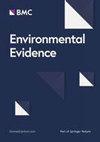What evidence exists on birds and mammals' biodiversity in the Brazilian Atlantic Forest (BAF) agricultural ecosystems? A systematic map protocol
IF 5.2
4区 环境科学与生态学
Q2 ENVIRONMENTAL SCIENCES
引用次数: 0
Abstract
Brazil has one of the planet's greatest biodiversity, with over 20% of the world’s total species. The Brazilian Atlantic Forest (BAF) spans 17 Brazilian states, making it the third-largest biome in Brazil. The BAF is composed of a range of ecological formations, with climatic conditions and landscape diversity that directly contribute to the different structures of the forest. The fragmentation of the original habitats, mainly due to anthropogenic activities, is one of the main causes of biodiversity loss, causing the decline and habitat loss for several species, including birds and mammals. While there has been extensive research on species diversity in forest fragments or protected areas, there is a lack of basic research in agricultural ecosystems. Only 1.5% of the studies on bird occurrence data in the BAF were reported from pasture habitats and 1.4% from exotic tree plantations. To address this gap, the present systematic map protocol aims to carry out a bibliographic survey on the presence of birds and mammals in agricultural landscapes and its adjacent areas of natural vegetation to describe the prevalence of species across different (semi-)natural and anthropogenic habitat types. Collecting this data is important to support environmental management policies to preserve biodiversity in these areas. We will conduct a systematic literature review on the biodiversity of birds and mammals in agricultural landscapes within the Brazilian Atlantic Forest as well as adjacent areas of natural vegetation. Our search will cover the following databases, without limiting the year of publication: Web of Knowledge, Scopus, and PubMed. We will also include grey literature such as dissertations and theses, performing the search at the “Biblioteca Digital Brasileira” database. The results will be screened for relevance based on predefined criteria. The screening process will take place in two stages: firstly, the articles will be screened by title and abstract, and then the eligible articles will be screened in full text. Only articles that meet the eligibility criteria will proceed to data extraction. The extracted data will provide the elements to build a systematic map.关于巴西大西洋森林(BAF)农业生态系统中鸟类和哺乳动物生物多样性的证据有哪些?系统地图协议
巴西是地球上生物多样性最丰富的国家之一,其物种数量超过世界物种总数的 20%。巴西大西洋森林(BAF)横跨巴西 17 个州,是巴西第三大生物群落。巴西大西洋森林由一系列生态形态组成,气候条件和地貌多样性直接造就了森林的不同结构。主要由于人类活动造成的原始栖息地破碎化是生物多样性丧失的主要原因之一,导致包括鸟类和哺乳动物在内的多个物种减少和栖息地丧失。虽然对森林片区或保护区的物种多样性进行了广泛研究,但对农业生态系统的基础研究却很缺乏。在《生物多样性公约》的鸟类出现数据研究报告中,只有 1.5% 来自牧场栖息地,1.4% 来自外来树木种植园。为了填补这一空白,本系统地图协议旨在对农业景观及其邻近自然植被区域中鸟类和哺乳动物的出现情况进行文献调查,以描述不同(半)自然和人为栖息地类型中物种的普遍性。收集这些数据对于支持保护这些地区生物多样性的环境管理政策非常重要。我们将对巴西大西洋森林及其邻近自然植被地区农业景观中鸟类和哺乳动物的生物多样性进行系统的文献综述。我们的搜索将涵盖以下数据库,且不限制发表年份:Web of Knowledge、Scopus 和 PubMed。我们还将在 "Biblioteca Digital Brasileira "数据库中进行搜索,包括灰色文献,如学位论文和毕业论文。搜索结果将根据预先确定的标准进行相关性筛选。筛选过程将分两个阶段进行:首先,将根据标题和摘要对文章进行筛选,然后对符合条件的文章进行全文筛选。只有符合资格标准的文章才能进行数据提取。提取的数据将为绘制系统地图提供要素。
本文章由计算机程序翻译,如有差异,请以英文原文为准。
求助全文
约1分钟内获得全文
求助全文
来源期刊

Environmental Evidence
Environmental Science-Management, Monitoring, Policy and Law
CiteScore
6.10
自引率
18.20%
发文量
36
审稿时长
17 weeks
期刊介绍:
Environmental Evidence is the journal of the Collaboration for Environmental Evidence (CEE). The Journal facilitates rapid publication of evidence syntheses, in the form of Systematic Reviews and Maps conducted to CEE Guidelines and Standards. We focus on the effectiveness of environmental management interventions and the impact of human activities on the environment. Our scope covers all forms of environmental management and human impacts and therefore spans the natural and social sciences. Subjects include water security, agriculture, food security, forestry, fisheries, natural resource management, biodiversity conservation, climate change, ecosystem services, pollution, invasive species, environment and human wellbeing, sustainable energy use, soil management, environmental legislation, environmental education.
 求助内容:
求助内容: 应助结果提醒方式:
应助结果提醒方式:


